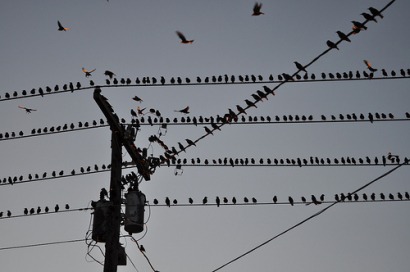
Almost fifty participants, mainly from the renewables industry, joined in Madrid to discuss how renewable energies and grid expansion can be reconciled with biodiversity conservation.
The proceedings are now available of the workshop that was organised by the Fundacion Global Nature and Global Nature Fund, together with the Spanish energy giant Iberdrola as part of the European Business and Biodiversity Campaign. The workshop provided a first overview of the different aspects that come into play when biodiversity is being considered in the renewable energy sector.
The morning started with a general outlook by Catharina Sikow-Magny, DG Energy of the European Commission. This provided the European framework for the different topics that were discussed during the rest of the day. The EU has ambitious goals for 2020 and aims to increase the share of renewable energies to 20%. To bridge the gap between production and consumption centres in Europe, this will necessarily be accompanied with a massive expansion of the grids. Both goals will not be achieved without environmental impacts.
Hydro, wind, and sun
The core of the workshop was formed by the break-out sessions, during which the participants were able to go into more detail on the dependence of the different energy sources (hydro, wind, solar) on biodiversity. During the hydropower session, it was discussed whether to build one large hydropower plant with an impact that is confined to one region or many small ones that proportionally have an even higher impact on biodiversity. It became clear that in any case, a decision for a hydro power plant means a compromise for nature. Even ecological measures, such as fish passes (if they work) can at the maximum mitigate the negative impacts.
The dangers of not taking into account biodiversity concerns were highlighted during the wind session, where the example of the Whitelee wind farm in Scotland was discussed. In this case, the presence of threatened birds prevented the construction of the wind farm. It was only after adequate measures to protect the birds were taken in collaboration with the RSPB (Royal Society for the Protection of Birds), that the continuation of the project was ensured.
Solar parks lead to the alteration of habitat as well, e.g. with the fencing of the area. Even as the sealed percentage of the site is relatively low, changes in precipitation or solar irradiation result from the establishment of a ground-mounted solar park. Positive examples however exist as well; if brownfield sites are converted into solar parks, even an enhancement of biodiversity can be achieved.
Expansion of the electricity grid
In the grid extension plans biodiversity conservation is playing an increasingly important role. Interesting examples were provided by Iberdrola which manages a large part of the grid in Spain.
As for the other companies of the sector the death of birds is the main problem. When it comes to the associated risks, it needs to be distinguished between high and medium voltage lines. For the high voltage spectrum the main issue is the collision of birds with the lines themselves. Many European companies have reacted and use different measures to increase the visibility of the lines through markings which are often installed by helicopters. For medium voltage the biggest danger is electrocution. This problem can be contained by the compliance with minimum distances between cables and the insulation of dangerous parts of the electricity poles.
Nesting of storks on the poles is another problem for its operation that Iberdrola faces. 12 years ago the company started to address this issue and for example installed alternative nesting poles and was able to motivate the stork to "resettle”.
The most astounding example of Iberdrola’s link with biodiversity however is the phenomenon that snakes climb the poles, confuse the insulators with birds, bite the lines and die from electrocution. This causes black-outs in about 20% of all cases. Together with the University of Salamanca, Iberdrola has therefore been conducting tests and will start to implement the solutions in the field next year.
The presentations given during the event can be accessed below:
• Catharina Sikow-Magny: "EU’s energy strategies for 2020 – 20% Renewable Energy and an Integrated European Transmission Network"
Breakout Session Solar
• Nadine Bethge: "How can biodiversity management be integrated in solar energy projects? The example of First Solar"
• Teodosio del Caño: "The example of Onyx Solar"
Breakout Session Wind
• Mandy Gloyer: "The Whitlee Windfarm. Addressing concerns and enhancing ecosystems. The Example of Scottish Power Renewables"
• Zarina Naseem: "The Project Good Practice Wind - how to reconcile environmental objectives and community issues with wind energy developments"
Breakout Session Hydro
• Cameron Ironside: "Promoting, improved sustainability performance through the Hydropower Sustainability Assessment Protocol: Biodiversity, reservoir management and downstream flow." [PDF]
• Johannes Reiss: "Development potential for hydropower from an ecological perspective"
Concluding remarks
• Deviah Aiama: "The Business Case to take a proactive approach to address environmental concerns for renewable energy projects"
Grid expansion
• Antonella Battaglini: "Best practices and guidelines to minimise impacts and stimulate public support for grid expansion"
• Liv Anne Becker: "Political recommendations for a socially and ecologically acceptable grid extension in Germany"
• Javier Goitia: "Grid extension to enhance biodiversity? The Example of Iberdrola"
• Christobal Bermúdez: "Grid extension to enhance biodiversity? The Example of Red Eléctrica de España"
• Richard Appleyard: "Is environment-friendly grid extension possible? (Discussion)"
[Inset: Courtesy of Josiah Bryan]
For additional information:

